

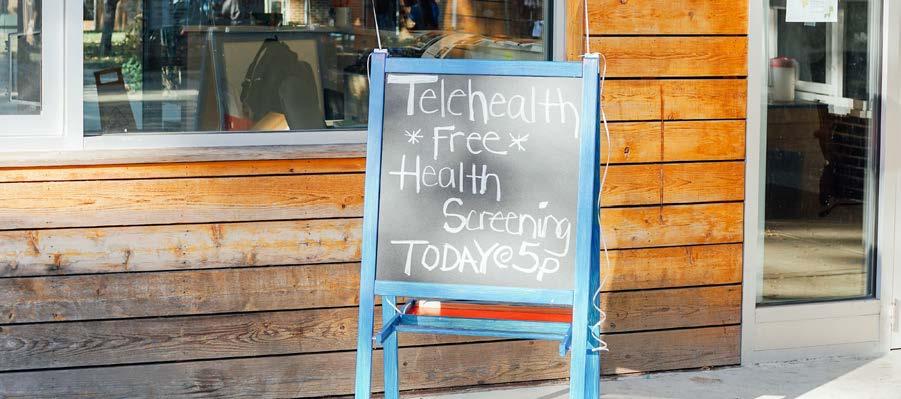






Community Opportunity Fund (COF) was awarded a contract through the Fannie Mae Sustainable Communities Innovation Challenge: Healthy Affordable Housing in May 2019, and then an extension contract in August 2021 to deliver the Telehealth Intervention Programs (TIPs) at Grace West Manor, a 429-unit Section 8 senior and family property, in Newark NJ, owned and managed by Jonathan Rose Companies.
TIPs is a multi-award-winning, preventative health screening program with wrap around social service programs targeting low-income, high health risk, underserved communities with the aim of addressing gaps in health equity and access, improving health outcomes and increasing social connectedness.
This report sets out the progress made during the course of the three-year Fannie Mae contract, with key results and achievements.
TIPs consists of weekly, in-person health screenings held on site at Grace West, monitoring individuals’ vital signs and asking health status questions predictive of hospitalization, with “wrap around” social activities. Results are reviewed remotely by a Registered Nurse practitioner who provides personal follow-up with medical advice.
The TIPs program acts as an early warning preventative strategy, enabling participants to remain in their community, significantly improving individual and community health, preventing hospitalizations/ER incidents, and reducing individual and health system costs.
The telehealth screenings are supported and enhanced by multiple health-related social programs, aimed at reducing social isolation, encouraging community connectedness and building a culture of health.
Long-term weekly remote patient monitoring (RPM) of basic vital signs and selfreported behavioral health status. Using on-site telehealth equipment, Telehealth Technician Assistants (TTA’s) check vital signs, ask behavioral health status questions that are predictive of hospitalizations and/or counsel participants and caregivers on available assistance.
The offering of culturally appropriate and relevant community-based services to address social determinants of health for residents. This includes health trainings, supplemental services for vision and diabetes, digital connectivity, vaccination clinics, and other services that address residents’ social, health, and behavioral needs provide a holistic, “whole-person” approach for individuals within TIPs.
The TIPs program enables participants to remain in community, improve individual and community health, prevent hospitalizations/ER incidents, and reduce individual and health system costs.
The COVID-19 pandemic fundamentally altered the delivery of the project. Our model was predicated upon a congregate setting with vitals screenings and wrap around social services being delivered to groups of residents. Many of the participants in the program are elderly and/or suffer from multiple chronic conditions and therefore fall into the highest risk categories for COVID.
Our services pivoted through multiple variations of the TIPs model in response to the changing COVID conditions through 2020, 2021, and 2022, including telephone wellness checks, in-home monitoring equipment and outdoor in-person screenings.
With the further reduction in rates of COVID cases in early 2022, together with the revised approach from the CDC and other health advisors on COVID protocols, the Grace West community spaces were fully re-opened in February 2022, which in turn enabled a return to the original congregate model of TIPs.
Jonathan Rose Companies (JRCo) ran multiple COVID vaccine clinics through the CDC Pharmacy Partnership program at Grace West and other properties in the portfolio.
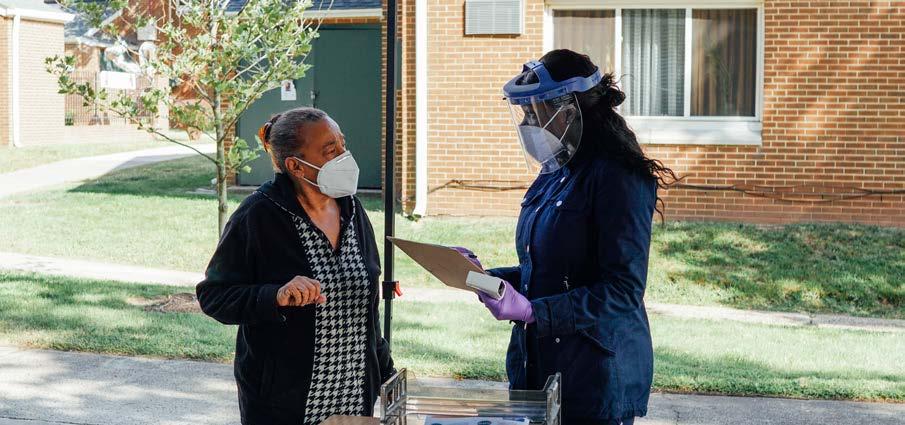
We analyzed participation rates at Grace West and compared rates for those enrolled in the telehealth program and those not enrolled in the telehealth program. The vaccine rate for TIPs participants at Grace West was 68% compared to 30% for non-TIPs participants, pointing to an increase in health awareness and agency among the TIPs participants.
We also analyzed the participation rates in vaccination clinics across the JRCo portfolio and explored whether the presence of a Resident Service Coordinator (RSC) relates to vaccine uptake rates. The presence of an RSC was associated with a 13 percent increase in vaccine rates.
The provision of health-related wrap around services has always been foundational to the successful implementation of the TIPs program. The combination of health screenings, together with robust social programming, aims to build social connectedness, improve health and wellbeing and build a holistic culture of health at Grace West.
Wrap around services are co-created with residents to meet their wants and needs. Throughout the years of this program, the wrap around services have addressed food security, mental health, community building and recreation, digital connectedness, and children’s enrichment to name a few areas.

The positive impact on residents’ lives can be seen in multiple resident anecdotes in the report.

TIPs has produced successful outcomes across a range of health metrics:
• Annual hospitalizations decreased from 16.5% prior to joining TIPS to 8.3% in the past 12 months, which represents a 50% reduction in reported hospitalizations since enrollment in the TIPs program.
• 30-day readmissions decreased from 1.4% to 0.2%, which reflects an 85% reduction over time.
• Reported falls decreased from 32% of participants experiencing falls in the first year of TIPs, to no additional falls reported at the point of analysis, representing a 100% reduction in falls.
50% Reduction in hospitalizations in TIPs participants compared to prior to TIPs enrollment
85%
Reduction in under-30-day re-hospitalization rates compared to prior TIPs to enrollment
100%
Reduction in the number of TIPs participants experiencing falls
An analysis of costs and quantifiable savings in the healthcare system resulting from these. reductions showed that the total healthcare savings of $244,626 outweighed the cost of running the program.
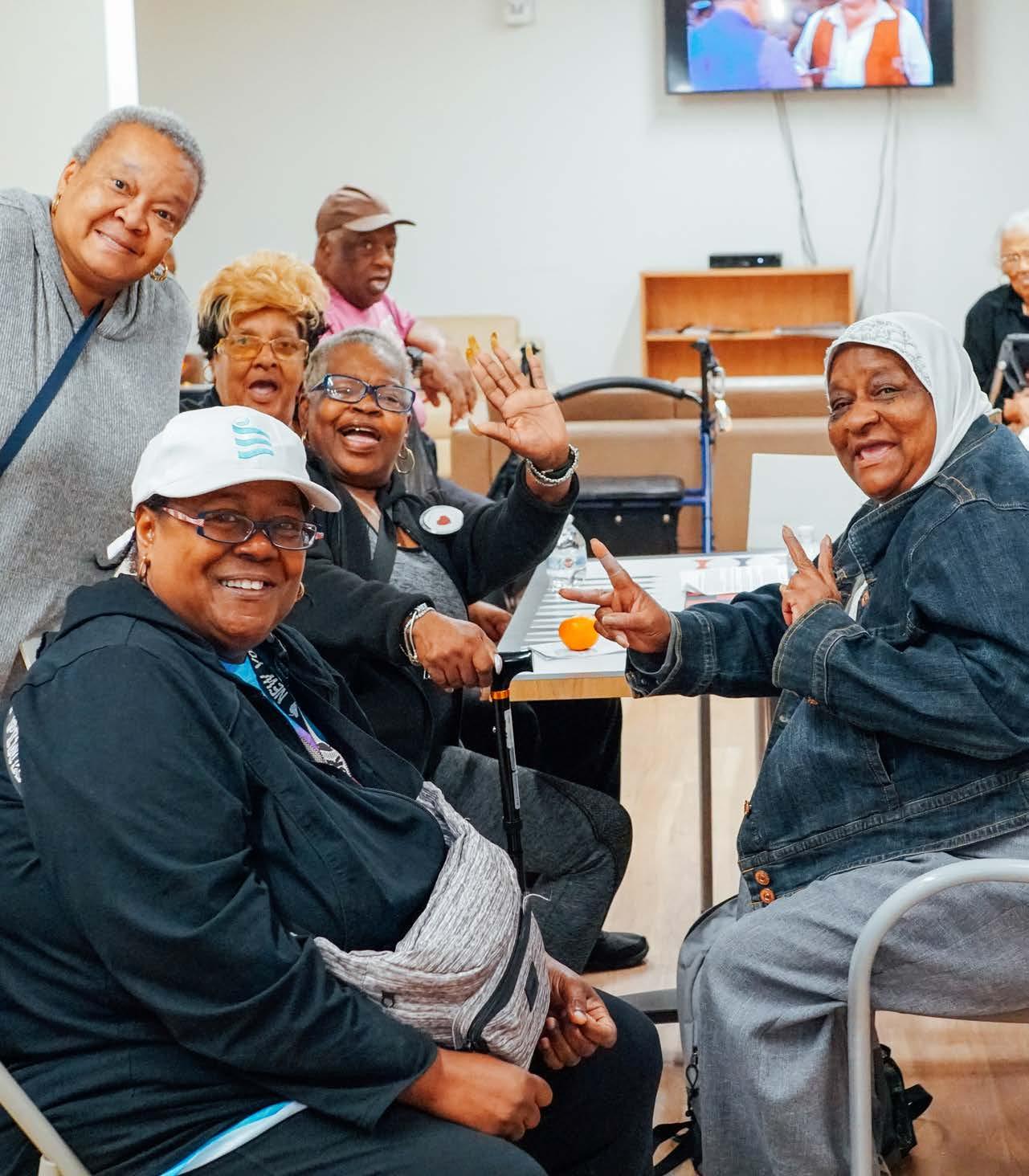
Community Opportunity Fund (COF) was awarded a contract through the Fannie Mae Sustainable Communities Innovation Challenge: Healthy Affordable Housing in May 2019, and then an extension contract in August 2021 to deliver the Telehealth Intervention Programs (TIPs) at Grace West Manor, a 429-unit Section 8 senior and family property, in Newark NJ, owned and managed by Jonathan Rose Companies.
Fannie Mae’s Sustainable Communities Innovation Challenge collaborates across sectors to support innovative projects that are tackling the challenges of delivering stable, healthy, affordable housing.
In underserved communities, affordable housing and health outcomes of residents are inextricably linked. This project brings telehealth and health-related wrap around programming into an affordable housing setting, aiming to help residents manage chronic health conditions, improve general health and wellbeing and help to build a culture of health. The TIPs program aims to analyze whether preventative health care services at a large affordable housing community can improve the health and wellbeing of residents and reduce health care costs.
The program, which started in 2019, aims to leverage telehealth services to improve health outcomes for the residents of Grace West Manor in Newark, NJ. It addresses the deep health and racial inequities that exist in our country. People who identify as Black, Indigenous, or people of color (BIPOC) face higher rates of diabetes, obesity, stroke, heart disease and cancer. Grace West is a community of color, with approximately 88% of residents identifying as Black or African American. This telehealth program is a critical component of the racial and health equity work being carried out at Grace West. The program is, by design, a social justice program with wrap around services being coproduced with residents. TIPs offers free and accessible healthcare and encourages agency and voice for residents in managing their health needs.
Mr. G (60’s, male)
• Mr. G manages diabetes, hypertension, and asthma.
• He has been a member since the launch of TIPs and one of the 60 residents with inhome monitoring devices through TIPs at Home.
• He checks his BP and Pulse Ox every day. He wasn’t feeling well on a weekend and decided to check his BP and Ox levels. Ox level was low so he called an ambulance and was taken to ER. The Dr. told him that having the pulse ox reader at home saved his life. The resident came and personally thanked the TIPs staff.
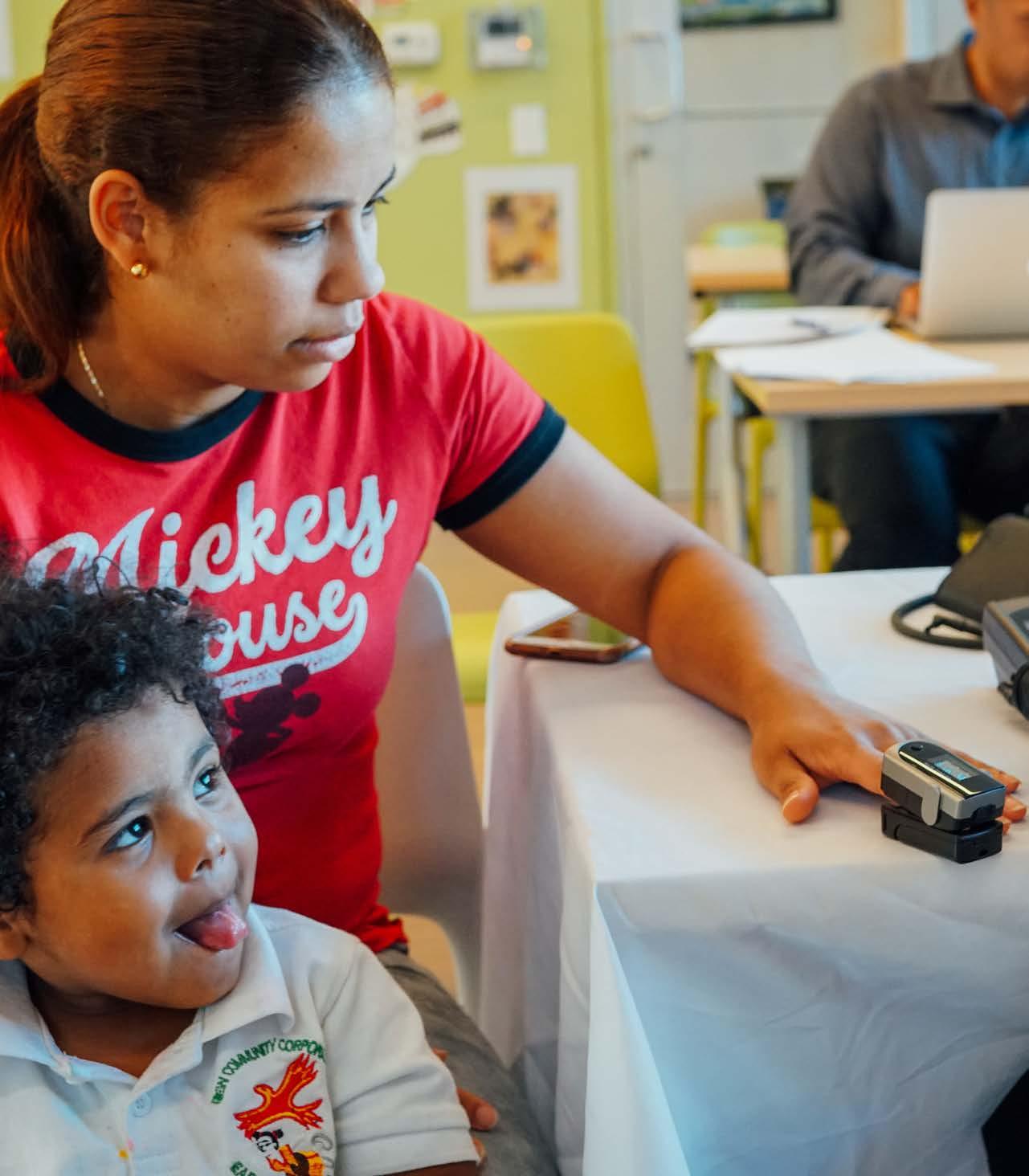
TIPs is a multi-award-winning, preventative health screening program with wrap around social service programs targeting low-income, high health risk, underserved communities with the aim of addressing gaps in health equity and access and improving health outcomes.
Using on-site telehealth equipment, Telehealth Technician Assistants (TTA’s) check vital signs, ask behavioral health status questions that are predictive of hospitalization and/or counsel participants and caregivers on available assistance. Telehealth equipment includes HIPAA-compliant Bluetooth blood pressure, blood oxygen, and weight scale connected to Wi-Fi. Information transmits to an electronic database dashboard, which a Registered Nurse reviews and uses to provide follow-up to the participant, primary care physician, and/or caregiver. Social programming, co-produced with residents, is delivered on site to support and enhance the telehealth services.
The TIPs model has proven that cost-efficient, long-term weekly remote patient monitoring of basic vital signs and behavioral health status, along with “wraparound” social services is an early warning preventive strategy enabling participants to remain in community, significantly improve individual and community health, prevent hospitalization/ER incidents, and reduce individual and health system costs.
Community Opportunity Fund partnered with The Westchester Public/Private Partnership for Aging Services (WPPP) and Jonathan Rose Companies (JRCo) to launch Telehealth Intervention Programs (TIPs) at Grace West. Our project team also includes Professor Matthew Neidell from the Columbia University Mailman School of Public Health, whose role is to analyze the data and draw conclusions on cost savings in the health care system as a result of the preventative care being delivered through TIPs.
Ms. M (70’s, female)
• Ms. M says that TIPs has helped foster a sense of community in that people get to know one another and can look out for each other more.
• As an example, she shared that when they were all down in the Community room as a group, they noticed that one of the residents did not look well. He ended up needing an ambulance called, which people might not have realized.
• Also says that seniors don’t always go to the doctor as much as they should and having a regular screening right in the building is convenient and helps people.
In June 2013, the Rose New Jersey Green Affordable Housing Preservation Fund acquired Grace West Manor, a 429-unit, affordable Section 8 property in Newark, New Jersey.
The property consists of a 12-story senior tower with 325 units, and family townhomes with 104 units. Grace West benefits from a long-term project-based Section 8 Housing Assistance Payment (HAP) contract. 100% of units are reserved for households earning below 50% of Area Medium Income. Between 2013 and 2018, approximately $4M of upgrades were undertaken, including modernized elevators in the senior tower, new energy-efficient boilers in the townhomes, and a new community center. In October 2018, the property was refinanced using Low Income Housing Tax Credits, enabling further capital improvements.
Physical improvements included upgrades to resident units as well as community spaces. The Community Room within the senior tower was modernized and an all season room was added to increase usable space and create a cohesive flow between the indoor and outdoor community areas. A fitness room and a consultation room were also added to the senior tower. These additional community spaces are part of Rose’s mission to build a culture of health at all Rose properties. The consultation space has been used for health screenings and benefits consultations.
Grace West benefits from two full-time Resident Service Coordinators (RSCs), one working primarily with seniors, and the other focused on families and youth. The RSCs work with residents and community partners to coordinate programs and events, make referrals, and support resident wellbeing through case management. The rapport built between the RSCs and Grace West residents was pivotal in the successful recruitment for and launch of the TIPs program.
In addition to two full-time RSCs previously in place prior to the launch of TIPs, an additional part-time RSC, specifically dedicated to the TIPs program, was hired in July 2019. This RSC assisted with recruitment of participants, raising awareness, and generating excitement about the Telehealth program. Upon the launch of screenings in September 2019, she also worked with community partners to coordinate wrap around services, continued to build rapport with residents to ensure their regular participation in the program, and is essential to the continued recruitment of new participants, in continuing to shape the social programming in response to changing resident needs, and in supporting and coordinating the delivery of the TIPs program.
Ms. S (70’s, female)
• Ms. S enjoys that the program is held at her building.
• The program has motivated her to stay active, and she is able to share the screenings with her doctor who is proud of her for taking this initiative.


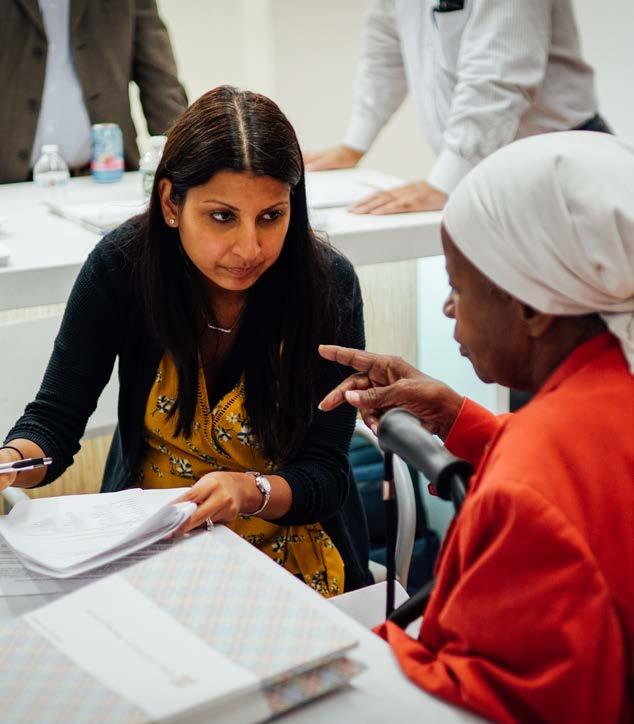
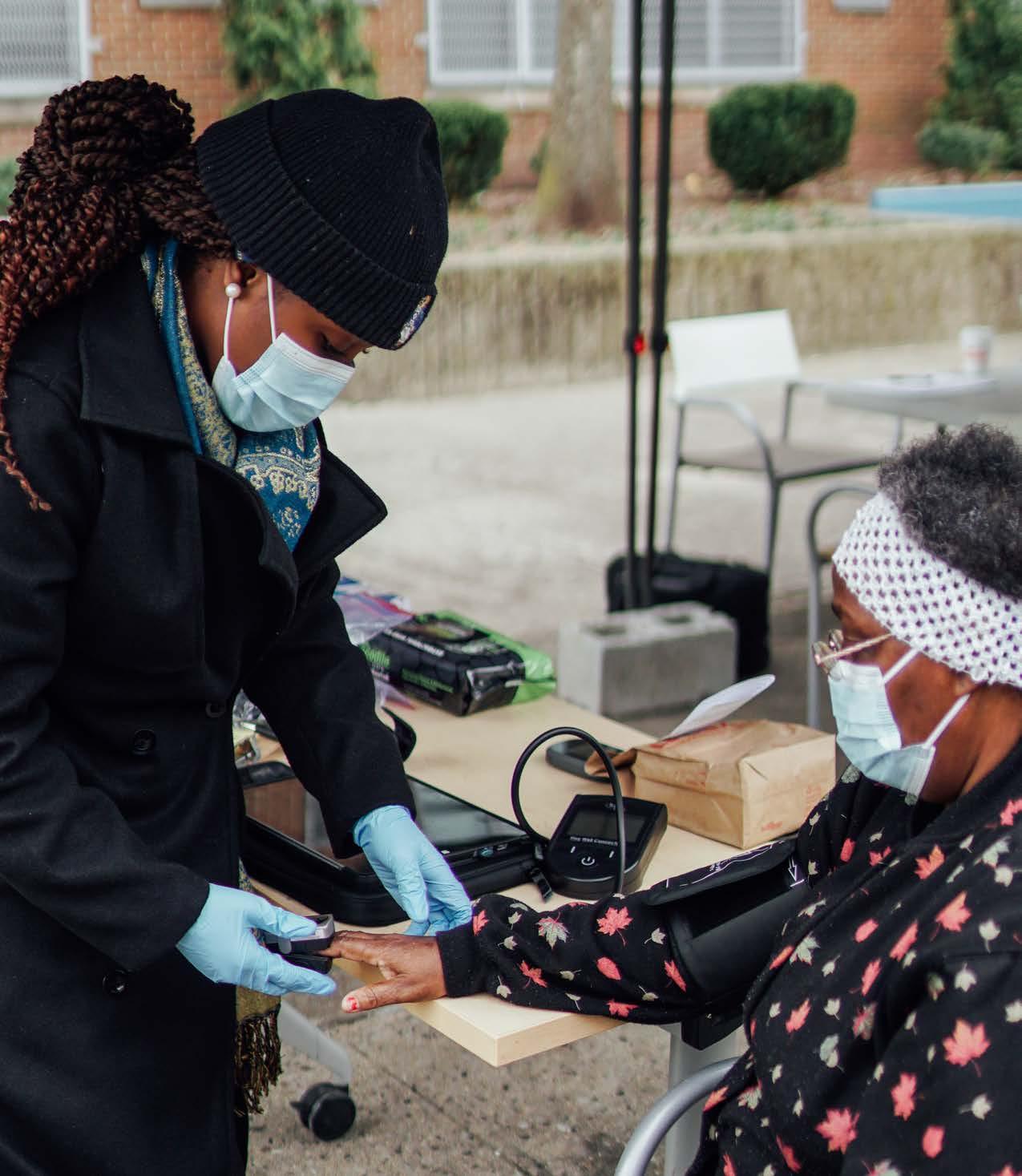
The emergence of COVID-19 had a significant impact on the program. We had to alter our delivery model many times in response to the changing COVID conditions. Although challenging at times, the experience of responding to varying COVID-19 regulations demonstrated the flexibility, and enduring popularity of the TIPs model. Set out below is a summary of the impact of COVID on the program and the way it was delivered.
After a successful pre-launch awareness and marketing campaign and detailed consultation with resident groups, we launched the TIPs program in September of 2019. The program was extremely popular with residents, and we quickly achieved our target number of enrollees. The telehealth screenings were supported and enhanced by multiple health-related social programs which gathered residents for activities such as eyesight and hearing screenings, chronic disease management classes, walking clubs, Zumba classes and more.
The classic TIPs model was based on a congregate setting program. In-person sessions were held twice-weekly on site, in the Grace West Senior Community Room and in the Community Center that serves the Townhomes.
The COVID-19 pandemic altered the project in some fundamental ways. Our model was predicated upon a congregate setting with vitals screenings and wrap around social services being delivered to groups of residents. Many of the participants in the program are both elderly and/or suffer from multiple chronic conditions and therefore fall into the highest risk categories for COVID. We took the difficult decision to temporarily suspend what we now call the “TIPs Classic” program on March 11, 2020. The program then went through a series of evolutionary changes to adapt to the COVID conditions, while continuing to connect residents to healthcare as effectively as possible.
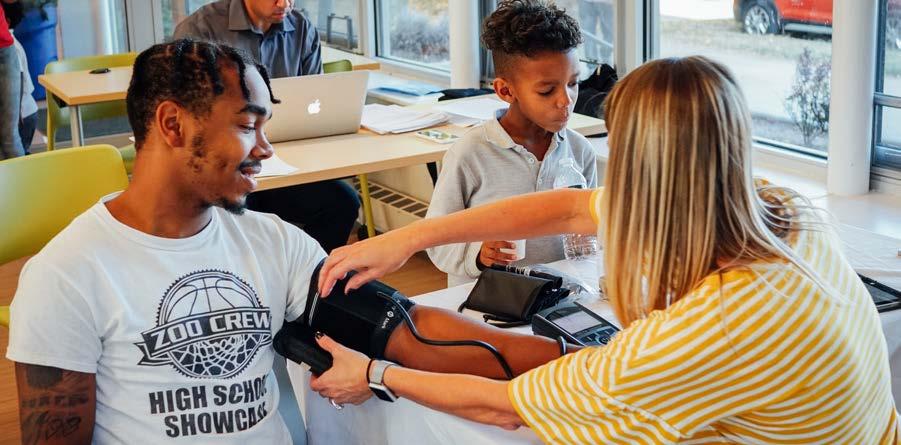
MARCH 2020
Covid-19 Shutdown TIPs in Touch launches
SEPTEMBER 2019
Launch of TIPs Classic
AUGUST 2020
TIPs Classic Outdoors launches
NOVEMBER 2020
TIPs at Home launches
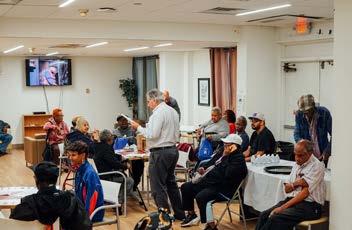
OCTOBER 2021
TIPs at Home Tech Pilot launches

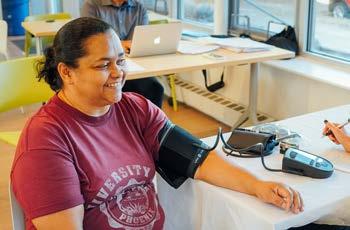

APRIL 2021
TIPs Classic Outdoors resumes

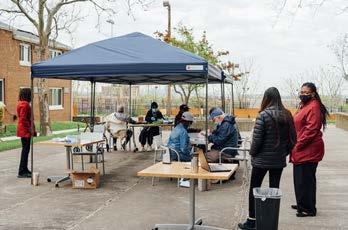
FEBRUARY 2022
TIPs Classic resumes

Within 2 weeks of the suspension of the program, we had implemented a “TIPs in Touch” telephone screening service, whereby our Telehealth Technician Assistants (TTAs) used enrollee lists to call all participants in the program. They asked standard behavioral health status questions that were in use as part of the telehealth screenings pre-COVID to check on residents’ general health and to enable us to continue to collect consistent data.
The system used responses to these questions to trigger health alerts, which were followed up by the remote nurse. Additionally, the social services wrap around programming shifted away from group programming and took the form of telephone wellness checks and ensuring consistent delivery of essential food and medical supplies to residents.
During a late summer window of opportunity in August 2020, when COVID cases in the region were dipping and the weather was agreeable, we launched a COVID-compliant TIPs Classic Outdoors service, in addition to the TIPs in Touch telephone wellness checks.
Through a carefully scheduled appointment system and strict COVID protocols, we were able to resume inperson vital signs readings in an outdoor setting, which minimized COVID transmission risks. These ended in October 2020 when a second wave of COVID infections began to materialize across the country.


Ms. R (60’s, female)
• “Telehealth has made me mindful of watching my weight and I have been eating more fruits and veggies and healthier foods.”
• “The nurse will follow up with me to address any concerns, and then I can bring it up with my personal doctors. It’s like having a second eye on my health.”
• She has lost weight and been exercising more thanks to the program.
Even during the TIPs Outdoors period, we were planning for a return to lockdown conditions, when we would not be able to hold in person sessions. With the agreement of Fannie Mae, we diverted funds within the contract towards the purchase of in-home vital signs monitoring equipment to enable residents to continue to manage their health from home. We knew this was important to residents, not just to collect vital readings but also to help counteract the social isolation and boredom that lockdowns brought with them.
By mid-November 2020, we had begun a phased rollout of in-home monitoring devices to a total of 60 enrollees. Residents were then able to collect their own vital readings as frequently as they wanted to and reported them to the TTAs during their weekly TIPs in Touch calls.
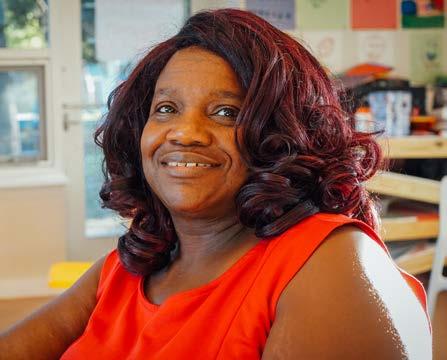

The TIPs team has also continued to expand the “TIPs at Home” program. Currently, 60 TIPs participants have received devices for their use at home. Each TIPs at Home participant received a blood pressure cuff, and pulse oximeter, and a notebook to record their readings. TTAs call participants and ask them to take their reading over the phone. These vital readings give the nurse same-day information so that she can follow up as needed to give advice or do a general check-in.

Building on the “TIPs at Home” program, on October 8, 2021, we launched the “TIPs at Home Tech Pilot” to pilot digitizing the process described above for 16 participants and in part to test the reimbursable aspects of this program. Sixteen participants received a “TIPs at Home Tech” kit. The kit includes a tablet that uses Bluetooth technology to automatically register readings taken by residents on their scale, pulse oximeter, and blood pressure cuff, all of which are also included in the kit. The introduction of the tablet streamlined the recording and monitoring process and allowed residents to skip the step of manually keeping track of their recordings. Since the readings are automatically registered and monitored, a TTA could more easily be in touch with the resident if any of the readings are high. The residents were taking their vitals daily, which helped people to be engaged in and in control of their own health, and in turn this might have a positive effect on reducing residents’ emergency room visits and ownership over their health outcomes. This element of the model can be reintroduced if there is sufficient funding to cover the monthly costs.
Ms. S (50’s, female)
• Ms. S is an active participant in telehealth.
• During the first few sessions she participated in, her high blood pressure was generating alerts through the telehealth program. Recently, it has been more under control which she attributes to these regular readings.

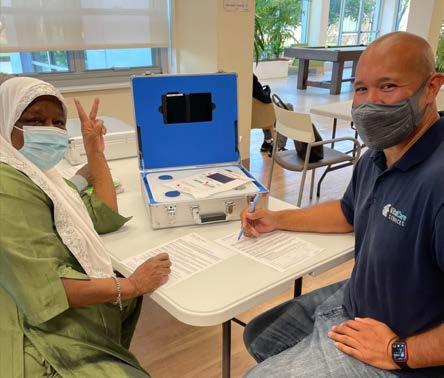
• Although she works, she always tries to come to the in-person sessions.
• Ms. S was given a Fitbit through the TIPs program, which she shares is very helpful in increasing her physical activity. She has been working to increase her daily step count.
In April 2021, with lower COVID transmission rates and a return to warmer weather, we restarted the TIPs Outdoors program, offering face-to-face screenings for the first time since the Fall of 2020.
The further reduction in rates of COVID case in early 2022, together with the revised approach from CDC and other health advisors on COVID protocols allowed for a full re-opening of the Grace West community spaces in February 2022, which in turn enabled our TIPs Classic model to be reinstated. Grace West staff and TTAs were once again able to support TIPs participants’ health and wellness through onsite weekly face-to-face screenings using CDC COVID safety protocols with about 50 residents in attendance each week. Wrap around services are simultaneously conducted in the large senior tower community space, and weather permitting, in the garden area that is common to the senior tower and the family townhomes.
The COVID-19 pandemic underscored the overwhelming pattern of inequality and racial health disparities that exist in our country. It called attention to the long-standing inequalities that pervade the health care system and society at large. We see these gaps as having potentially widened during COVID, making this program even more vital for residents.
The TIPs program model and services have demonstrated considerable innovation, resilience, and demonstrable impact at both the individual, community, and population-health level. In view of the critical nature of the ongoing COVID-related population health issues, the importance of vaccination for individual safety, control of the spread of COVID and its variants, especially among the most vulnerable population, and resulting economic impact on all sectors of society are possible challenges. TIPs has demonstrated its value in responding to these challenges at all levels and continues to serve as a model for progress in these areas in the future.
Ms. W (60’s, female)
• Ms. W shared with the RSC that she learned from the nurse that dehydration can impact blood pressure, and when her BP is high, the nurse has suggested she drinks more water.
• Ms. W “loves” the nurse and closely follows her advice.
• She also spoke about how the program can create a sense of community because it sparks conversation about health amongst friends that they might not otherwise be having.
• She mentioned the friendly competition she and her friends in the program engage in, which encourages them all to have better habits and talk about their health.
• Ms. W reports continued weight loss toward a healthier weight with improvements in her diet and movement.

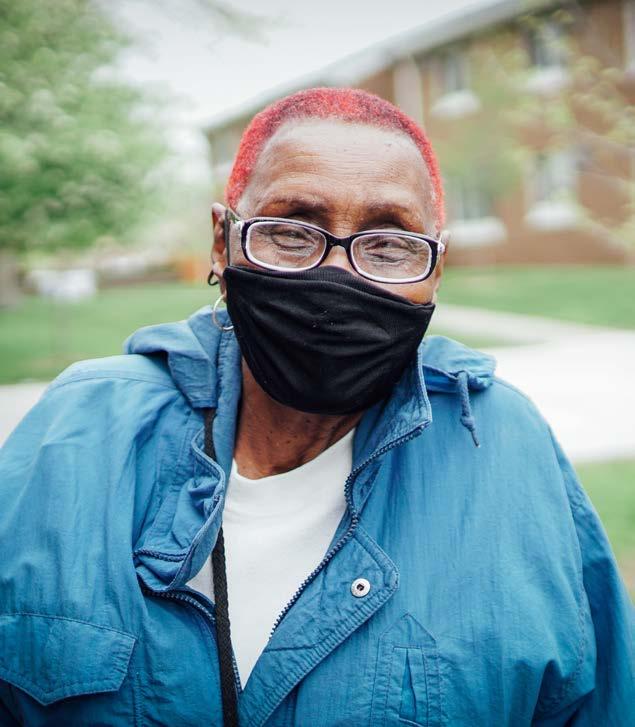
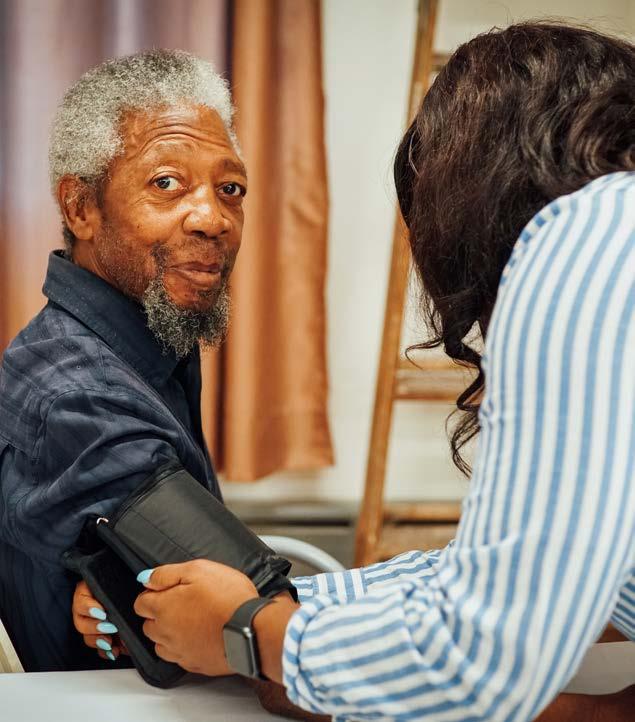

Although the spread of COVID and the ensuing lockdowns led to a disruption in the delivery of services, it also created a new opportunity to explore how our program may have influenced vaccine take-up. The race to vaccinate against COVID became an important goal for the program.
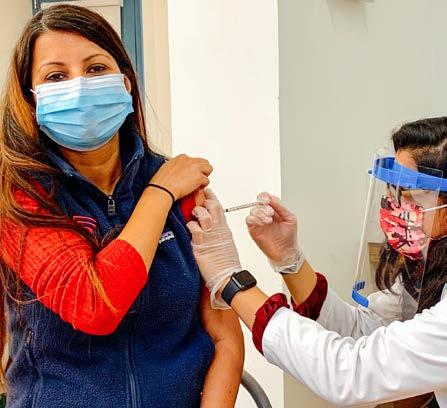
Jonathan Rose Companies successfully applied to be part of the CDC’s Pharmacy Partnership Program which delivered vaccines initially to elderly and vulnerable sections of the population, at a time when vaccines were very scarce. RSCs at Grace West worked in partnership with Walgreens to provide on-site COVID vaccine clinics in January and February 2021. 175 Grace West residents were vaccinated as part of the early Pharmacy Partnership program.
Despite the availability now of multiple, effective vaccines, hesitancy was a major hurdle when vaccines first became available. The initial hesitancy was particularly notable in African American and other minority communities, who not only suffered disproportionately from COVID but also initially indicated a lower willingness to obtain a vaccine. Lack of trust, stemming from centuries of historic systemic racism and discrimination, may have been a contributing factor.
Access to “trusted messengers” - our Resident Service Coordinators - who deliver clear, transparent messages regarding vaccine safety, effectiveness and availability may have helped to increase take-up for this group. Other studies have suggested that religious leaders and other community leaders can serve as trusted messengers for increasing vaccine take-up. We believe that the frequent interactions with residents suggest that the involvement in TIPs, especially with the presence of an RSC, may serve as another venue for creating a trusted messenger.
To assess this, we proceeded in two steps. First, we compared the mean vaccination rate of TIPs participants to non-TIPs participants at Grace West. Three COVID Vaccination Clinics were held at the senior tower at Grace West in January and February 2021 as part of the CDC’s Pharmacy Partnership Program. The vaccine rate for TIPs participants at Grace West was 68%, compared to 30% for nonTIPs participants. When we later surveyed 31 TIPs participants about vaccination beliefs, 52% indicated that participation was helpful in that decision.
VACCINE
30% Non-TIPs Participants
Second, to explore whether these results may hold more generally, we explored whether the presence of an RSC relates to vaccine take-up rates. We gathered data on vaccine rates, presence of an RSC, and demographic characteristics of the residents from 47 properties managed by JRCo (including Grace West), all of which ran three COVID vaccine clinics through the CDC’s Pharmacy Partnership Program as well. We performed a multivariate linear regression of vaccine rates on an indicator for RSC presence, adjusting for demographics.
Summary statistics indicate that approximately 51% of the 10,219 residents across all properties had been vaccinated. 51% of the properties had an RSC present. The regression analysis indicates the presence of an RSC was associated with a 13 percent increase in vaccine rates. We found higher vaccine rates for older populations (41.6 percentage point increase), consistent with vaccine rollout policy, and lower vaccine rates for African Americans (10.7 percentage point decrease), although these figures date from the time of early vaccine availability. Racial disparities in vaccine take-up have narrowed over time (or in some cases reversed) and vaccine uptake figures are now likely different.
We recognize important limitations in this analysis. As an observational analysis, confounding is a possibility. Participation in TIPs is voluntary, opening the possibility of selection bias whereby factors correlated with TIPs participation may explain the difference in take-up. Similarly, despite the inclusion of several control variables, properties with an RSC may differ along other, unobserved dimensions that explain the higher vaccine take-up rate.
Nonetheless, given the timeliness of the issue and the need to act on limited knowledge, our study suggests that connections formed through place of residence may aid in creating trusted messengers who encourage vaccine take-up, further supporting the notion that trusted messengers is one strategy for increasing vaccine uptake to improve public health and the fight against COVID.
• Ms. B reported that the nurse checkups through the TIPs program have helped her improve her habits of monitoring and treating her high blood pressure.

• She was a consistent participant in the TIPs at Home Program. She received her own equipment and continues to check in weekly with the TTA and follows the nurse’s advice on any alerts.
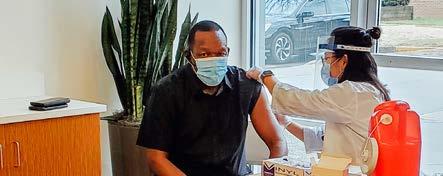

The TIPs team has always considered wrap around services to be foundational to the successful implementation of the TIPs program. The overarching goal of the program has been to build a holistic culture of health and wellness with our residents while improving connectedness and reducing social isolation.
Our first step, as always, starts with understanding the residents’ needs. As TIPs launched, data was gathered during intake indicating that most participants were managing multiple chronic health conditions, such as COPD, diabetes, asthma, etc. Education around the management of chronic health conditions was an important first step in setting the stage to build a culture of health. Residents participated in health trainings and supplemental services for vision, diabetes, colorectal cancer, Alzheimer’s awareness and brain health, tobacco cessation, among others. Partners included the American Heart Association, Elite Caring, Have Shoes Will Travel, Rutgers University, the Rutgers Cancer Institute of NJ, African-American Brain Health Initiative (AABHI) at Rutgers. Additional programming to build a culture of health at Grace West included nutrition programs to promote healthy eating and Zumba classes to promote movement. Fitbits were also distributed to a subset of participants to track steps taken and further motivate participants to include movement in their daily lives, including through a walking club set up by residents.
Other wrap around services to improve residents’ lives and wellbeing included those that addressed food security, mental health, community building and recreation, digital connectedness, and childrens’ enrichment programs to name a few.
Over 200 bags of Hello Fresh meals and produce were distributed twice a month and over 145 boxes were distributed each month through the Community Food Bank of NJ. The Mental Health Association of NJ provides bi-monthly stress reduction sessions for all Grace West residents. Telehealth participants are fully engaged in these sessions and have provided positive feedback on their helpfulness to inform future programming.
On-site staff ensured many events to continue to keep residents connected, including a Summer Feeding and Enrichment Program for children, a summer camp program that offers free activities on campus including outdoor play, STEM classes, arts & crafts, and cooking and nutrition workshops. Additionally, Community Police Officers hosted “paint and sip” nights (with healthy beverages), and “Coffee with a Cop” social hours. Grace West participates annually in National Night Out, a nationwide event that brings together community, police, and local organizations for a positive evening focused on neighborhood safety, unity, and fun.
Looking forward, the team is focused on continuing to build social connectivity and helping participants with emerging needs that have developed over the past year, such as digital connectivity and behavioral health.
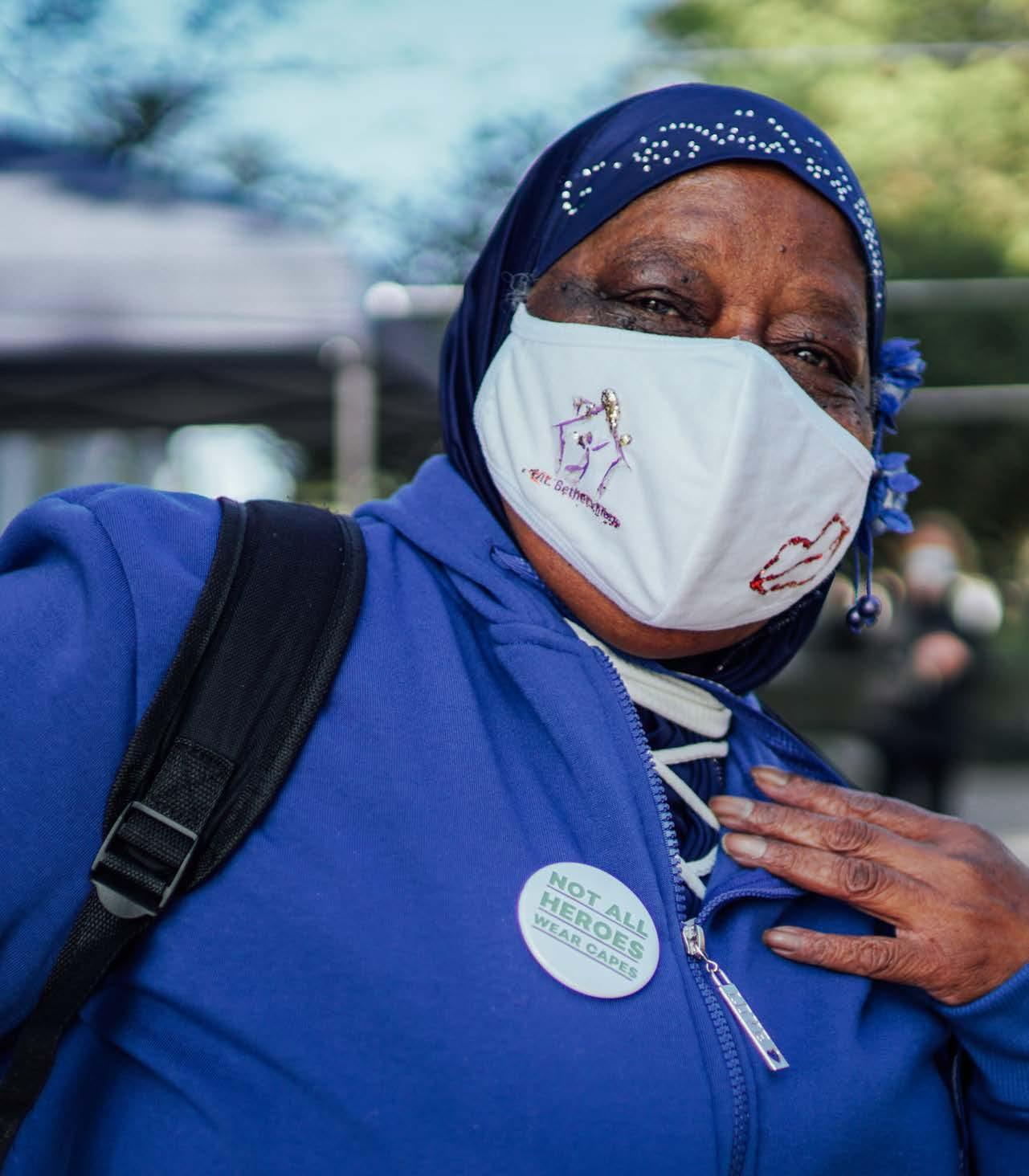
The Patient Activation Measure (PAM) is a well validated instrument used in the healthcare industry to measure health-related confidence, engagement, behaviors, and lifestyle to establish baseline health engagement and changes over time and circumstances. The PAM survey measures four levels of patient activation levels:
PAM surveys have been conducted periodically throughout the duration of the program. A total of 524 surveys have been administered to 215 TIPs participants since the start of the program.








5. Patient Activation Measure: Health Behavior Impact of TIPs

Overall, the results presented here indicate positive effects of the TIPs program on improved health monitoring and self-advocacy behaviors, and impact on health behaviors during COVID.
This section presents the overall comparison of PAM baseline results at implementation through Fannie Mae Innovation Grant contract completion and reflects changes in the initial levels of patient activation with those of the most recent levels.
Most notably, there was a substantial decrease (-38%) in the number of participants in Level 2 and a substantial increase (+15%) in the number of participants in Level 3.
Overall, these trends suggest positive changes in participants becoming more engaged in the monitoring and managing of their health.
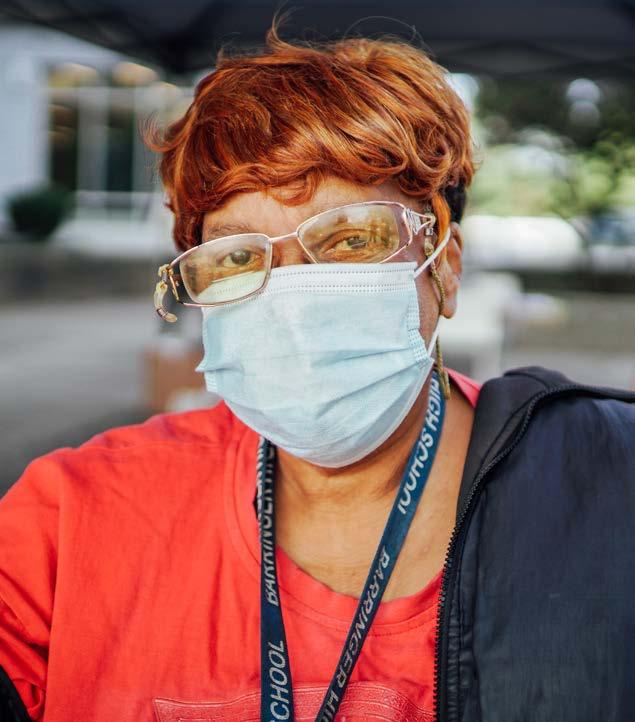

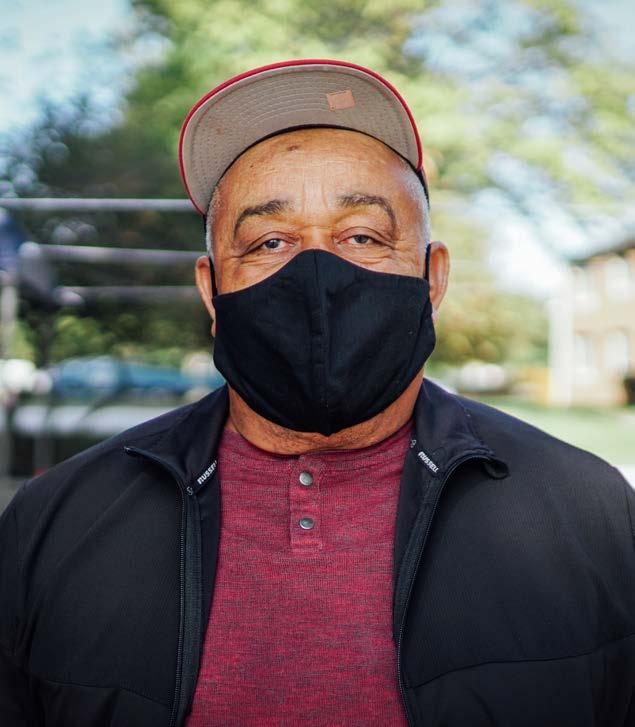
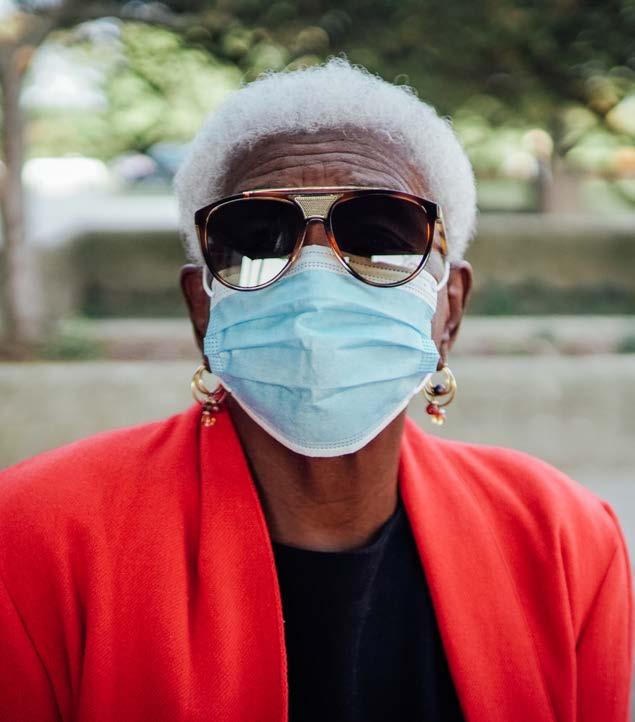
This section presents changes in scores from baseline to follow-up within each of the four PAM Levels. Most notably, average scores increased by +9.8 (+22%) points in Level 1 and +8.2 (+16%) points in Level 2, indicating some improvement in lower-scoring participants despite their being in the lower range of engagement with their health behaviors. Importantly, roughly 86% of participants in Level 1 and 75% of participants in Level 2 displayed increases in their scores, indicating substantial improvements for the majority of people in each of these lower Levels. Average scores decreased by -1.9 (-3%) and -10.21 (-13%) points in Level 3 and Level 4, respectively (noted particularly in monitoring during and following COVID restrictions).
It is perhaps unsurprising that feelings of health-related confidence reduced during a public health crisis like the COVID-19 pandemic when answers to questions like: “I have been able to maintain (keep up with) lifestyle changes, like eating right or exercising.”; “I know how to prevent problems with my health.”; “I am confident that I can figure out solutions when new problems arise with my health.” become very much more difficult to answer.
Despite these decreases, participants in Levels 3 and 4 still maintained relatively high levels of engagement with the monitoring and management of their health behaviors. In general, these results are consistent with the changes in trends, suggesting considerable improvement in participants embracing a more active role in their health behaviors and attitudes through participation in the TIPs program.
• Ms. H spoke about how the TIPs program can help you age in place, as it can be an early warning sign for health issues that, if left unchecked, could potentially lead to the need for a higher level of care.

• The program is a great reminder to take medication - the nurse’s advice is helpful in controlling high blood pressure.
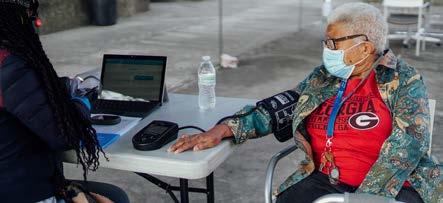
• She also discussed how the program can help you “take control of your health” which can lead you to taking control of other areas of your life and forming better habits.
• Ms. H spoke about how it can make you want to “stay home where you have control” and about the importance of being independent as you age.

Ms. P (70’s, female)
• After joining TIPs, Ms. P reports that she is optimistic about her health and doesn’t feel alone managing a chronic disease or managing her diet.
• She stated she is very pleased with the oxygen level screening as she is asthmatic, and it is important for her to know her oxygen level.
5. Patient Activation Measure: Health Behavior Impact of TIPs
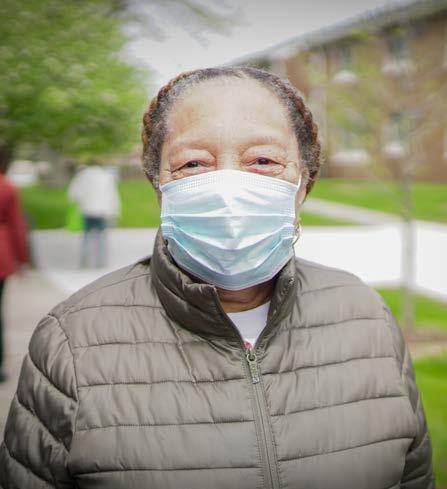

In this section, we provide the details and results of our analysis of the impact of TIPs on participants’ outcomes. After providing background information about TIPs enrollees, we provide evidence of the impacts on health care usage, including a cost-effectiveness analysis, as well as impacts on housing stability. We focus our analysis on residents at the senior tower (Grace West Manor) where active TIPs enrollment was considerably higher. We performed these analyses at five stages: February 2020, November 2020, and May 2021, May 2022, and September 2022.
Details about the number of participants enrolled in TIPs over time at Grace West Manor are displayed in Exhibit 1. Enrollment grew steadily during the first few months when the program began, and then began to plateau by the end of 2019. After the interruptions caused by the COVID-19 pandemic, enrollment remained consistent for over a year. This is not surprising since during the COVID-19 pandemic we concentrated efforts on delivering services to existing enrollees, rather than on recruiting more participants. Enrollment picked up again once we resumed outdoor, in-person sessions, through natural means as a result of carrying out readings outdoors, in the middle of the Grace West campus. Enrollment continued on an upward trend over the past year, with 212 residents enrolled as of September 2022.
Characteristics of the people enrolled as of September 30, 2022, are displayed in Exhibit 2. Participants from the senior tower have an average age of 69, consistent with the age requirements for residence. Over two-thirds of the participants are on Medicaid, a government insurance program for low-income adults. Most participants in the program are female (58%), likely reflecting high life expectancy for female seniors. These values have been reasonably constant over time, with the increased age coming from remaining in the program. Over half of the enrollees have a chronic condition, with older age a likely explanation behind the trend of increasing co-morbidities.
Notes: Data collected on participants through 9/30/2022. Chronic conditions consist of Hypertension, diabetes, and COPD.
Ms. M (60’s, female)
• Ms. M manages COPD, Coronary Artery Disease, and has suffered a stroke.
• She has been a member since the launch of TIPs and one of the 60 residents with inhome monitoring devices through TIPs at Home
• She received a Fitbit through the TIPs program and has walked over 1 million steps.
• She completed nutrition classes and Chronic Disease Self-Management classes through the TIPs wrap-around programs.
• She joined the Zumba classes, that were also part of the wrap-around programming.
• Since enrolling in TIPs, Ms. M reports that she is more mindful of her health, has started to walk more and now always takes part in educational and health-related programs offered at Grace West.
Over the course of the TIPs program, we analyzed the change in hospitalization rates, 30-day readmissions, and reported falls for TIPs enrollees. During our weekly sessions, we asked participants if they had been hospitalized during the past year, readmitted to the hospital within 30 days of the original admission, and whether they experienced a fall. Since we collect the data for hospitalizations and readmissions at our initial intake survey, the first response to these questions reflects the “pre-TIPs enrollment” period. Questions asked at later stages, after TIPs enrollment, are annualized to reflect the “post-TIPs enrollment” period. To assess the impact of TIPs, we compare the outcomes in the pre- and post-TIPs periods. Data on reported falls was only collected after TIPs enrollment. For that outcome, we assess the change in falls over time. Results for these outcomes are summarized in Exhibit 3.
Notes: All data are reported in percent. Post-TIPs enrollment percent for data through February 2020 are based on estimated annualized outcomes.
For hospitalizations, we witnessed an increase in the beginning that leveled out over time and eventually an improvement. By September 2022, annual hospitalizations had decreased from 16.5% prior to joining TIPS to 8.3% in the past 12 months, which represents a 50% reduction in reported hospitalizations since enrollment in the TIPs program. For 30-day readmissions, we saw consistent declines over the period of analysis, with a decrease from 1.4% to 0.2%, which reflects an 85% reduction as of September 2022. For reported falls, we also saw a steady improvement over time, with a decrease from 32% of participants experiencing falls in the first year of TIPS, to no additional falls reported at the point of analysis, representing a 100% reduction in falls.
50% Reduction in hospitalizations in TIPs participants compared to prior to TIPs enrollment
85%
Reduction in under-30-day re-hospitalization rates compared to prior TIPs to enrollment
100%
Reduction in the number of TIPs participants experiencing falls
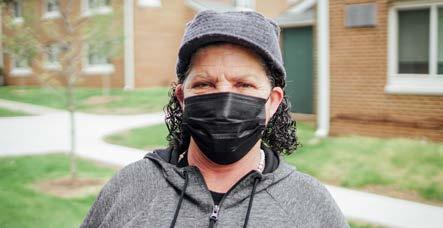
We conducted a cost-effectiveness analysis (CEA) to succinctly summarize the cost impacts of TIPs. We calculated the annual costs of the TIPs program to Grace West residents based on internal estimates of the cost to deliver services plus any relevant line items in the JRCo budget. We monetized the changes in healthcare utilization based on the changes in outcomes measured from the healthcare usage analysis. Any such analysis is always filled with limitations, and unique circumstances due to the COVID-19 pandemic even further that. We outline several of these caveats below.
To estimate the cost of TIPs, we used existing estimates for “TIPs-classic” for one full year. The TIPs costs include the costs of a nurse, TTA, travel, hardware, software, licensing, and other administration tasks. Given that TIPs as delivered at Grace West involved additional costs (involvement of a Resident Service Coordinator, promotions, and other activities to recruit participants, and a security guard) not included in the TIPs classic estimate, we also included costs from the JRCo budget for these items. Exhibit 4. reflects the overall costs to deliver TIPs at Grace West.
We did not include the cost of wrap-around services since some already existed absent TIPs, and many were secured at no cost. We also did not include indirect costs associated with the project team to coordinate and analyze TIPs. These costs center on establishing TIPs as a viable service and providing proof of concept. That is, these are costs that are not necessary for establishing a new TIPs program and would not be part of the calculus for assessing financial sustainability.
To measure healthcare savings, we focus on hospitalizations and 30-day hospital readmissions as our measure of healthcare utilization. This outcome improved for TIPs residents and is readily monetizable using estimates of the cost of hospitalizations. We used outcomes measured from September 2022, the most recent collection wave. Exhibit 5 reflects the monetized healthcare savings from TIPs.
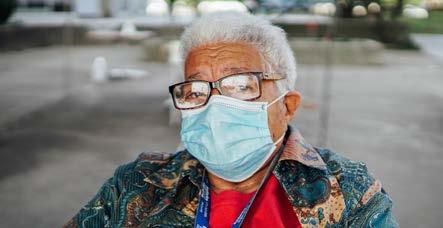
We recognize that using changes in only this outcome reflects a partial accounting of the full range of impacts for participants because it does not monetize all of the potential benefits to participants. At least three items are not included. One, the hospital costs do not reflect the full costs to residents, such as the role of any caregivers and the pain and suffering of the patient. Two, we also found evidence that the program improved reported falls, which represents an additional benefit not readily monetized. Three, there may be other benefits to participants that we did not measure, possibly because they have yet to accrue.
An example of an additional health benefit that TIPs enrollees may experience is improved COVID outcomes because of the higher COVID vaccination rates (described in Section 3.7). We can combine this finding with information on background COVID rates and vaccine effectiveness to provide an approximate estimate of the number of COVID hospitalizations and positive cases avoided. We approximate that, because of the improved vaccination rates attributable to TIPs, we avoided 0.26 hospitalizations and 1.90 positive cases of COVID. If we value the change in hospitalizations at current reimbursement rates, this would contribute an additional $6,342 to the healthcare savings, which is roughly 24 percent of the savings shown in Exhibit 5. We recognize these as speculative measures only meant to be suggestive of the potential additional savings.
Bringing the cost and quantifiable savings together, the healthcare savings of $244,626 outweigh the costs of $169,886, indicating the TIPs program has provided a net cost saving to society. Given that we have erred on the side of overstating the cost of the program and understating the benefits, this is a conservative estimate that likely understates the true percent of costs recouped. We know from resident anecdotes that other health care interventions may have been avoided as a result of TIPs, but it is difficult to quantify the benefit due to the qualitative nature of the information.
$244,626 Health Care Savings
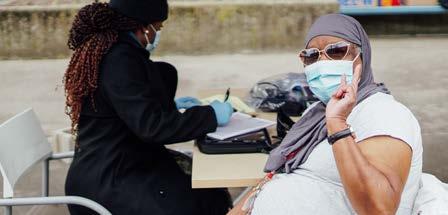
Participation in the TIPs program has the potential to improve housing stability. Improvements in health outcomes and reduced health care costs can ease the overall financial burden for residents, leaving more money in people’s household budgets to pay for other things, such as food and rent. Likewise, the increased access to wrap around services may help connect participants to other resources that may provide financial help, also enabling more resources for rental payments. In addition to these financial channels, TIPs participation may improve engagement and empowerment, which may improve lease adherence.

We focused this analysis on two housing stability measures: ledger balance and eviction proceedings. Ledger balance is a particularly relevant measure of adherence to lease terms and for determining whether to proceed with evictions due to financial reasons. We obtained data on each occupant’s ledger balance from March 2018 to September 2022, providing 4.5 years of data. Importantly, this includes the time period before we began the TIPs program at Grace West. This enables us to assess how the ledger balance of occupants evolved over time. The ledger balance data also provided information on the unit, including the lease total, square footage, number of occupants, age of the lease holder, and tenure of the occupant, which was calculated from the move in date. Evictions data is only available more recently due to the Federal and local laws limiting evictions in response to COVID. We used detailed lists of eviction proceedings, which included the unit number to enable us to identify TIPs and non-TIPs participants.
The ledger balance and associated information was available for the residents of all 305 units at the Grace West senior tower. The data therefore includes not only TIPs participants but also residents at Grace West who did not participate in TIPs. Using our detailed records of TIPs participants, we classified each resident into one of three categories: 1) TIPs active; 2) TIPs inactive; and 3) no participation in TIPs. Since it is difficult to classify the participation of those inactive in TIPs, we limit our analysis to those active in TIPs, and define those who never participated in TIPs as the “comparison” group.
• Ms. B is thankful for this program because she understands her condition, learned how to use her blood pressure machine, and can help her son who is managing the same condition.
• She said she is lucky to be able to participate and get all the assistance TIPs offers.

Of the 305 residential units at the senior tower, 205 had residents who were at Grace West when TIPs started. To ensure that our analysis focuses on a consistent group of tenants, we use the 205 residents that have continuously resided at Grace West. Of those 205, 80 are considered active in TIPs, 102 were never involved in TIPs, and 23 were excluded due to TIPs inactivity.
Exhibit 6. shows show basic characteristics of the housing stability data. In August 2019, prior to the TIPs program, the average unit owed $9 in their ledger balance. By March 2022, that number increased to $587, a pattern consistent with the harder financial times brought on by the pandemic. By September 2022, this had further increased to $778. In August 2019, 61 out of 205 units had a balance of $0, and that number fell to 33 by March 2022 but increased to 38 by September 2022. As of March 2022, a total of eight eviction proceedings had started for the 205 continuously occupied units, representing 3.9% of units. By September 2022, this increased to 24 units (or 11.9%).
Exhibit 7. shows the characteristics of the 205 units, separately for the 80 active TIPs participants and the 102 tenants who never enrolled in TIPs. As this table shows, TIPs and non-TIPs units are quite comparable in terms of the square footage, lease total, number of occupants, and tenure at Grace West. Only age appears somewhat different, with TIPs participants being 1.3 years older on average. This similarity in baseline characteristics between TIPs and non-TIPs participants helps to limit possible concerns from confounding.
We explore how the ledger balance of TIPs participants changed over time and compare this to how the ledger balance of the non-participants changed over time. The use of this comparison group enables us to overcome some of the issues created by the COVID-19 pandemic. That is, the comparison group gives a sense of how the outcome was altered by the pandemic; we can compare the change for the TIPs group to the change for the comparison group to yield insights into the impact of TIPs.
As shown in Exhibit 8. TIPs participants had an average ledger balance of -$48 prior to TIPs arrival at Grace West. By September 2022, this balance had increased to $679, representing a change of $727. For non-TIPs participants, the ledger balanced of $98 prior to TIPs increased to $831 over time, representing a change of $733. The difference between these two changes ($727 vs. $733) suggests that TIPs participants owed $6 less than non-participants, which represents a minor improvement in housing stability.

• Ms T has been a participant of TIPs for 3 years now and reports that being part of this program has encouraged her to take better care of her health. She now routinely tracks her blood pressure which she had trouble doing so before or did not know where to begin.
• She is proud to say thanks to TIPs and has learned a lot about her condition and even guides/encourages friends and family to enroll in TIPs.

We also performed a similar comparison for TIPs participants by comparing those who were particularly active in TIPs (“high-usage”) vs. those who were less active in TIPs (“low-usage”). We define this level of activity in TIPs by measuring the fraction of TIPs weekly events that participants attended and splitting the group into the highest quarter (those who attended > 62% of events) and lowest quarter (<10%). Shown in Exhibit 9. high- and low-usage participants had a balance of $5 and $37 prior to TIPs arrival at Grace West, respectively. As of September 2022, the balance of high-usage participants had increased slightly to $14 while the balance of low-usage participants had increased to $569. This implies that the balance of highusage participants had improved by $592 relative to low-usage. This suggests that the more active one is in TIPs, the greater the benefits are to their housing stability.
Note: high usage defined as top 25% of users (>62%), low usage defined as bottom 25% (<10%)
Since we only have recent outcomes for evictions, we cannot explore changes over time as we do with ledger balance, but instead only explore the current relationship between TIPs status and these two measures of housing stability. The results, shown in Exhibit 10., illustrate that eviction proceedings are comparable across TIPs status, with ten of 80 TIPs participants experiencing a proceeding and nine of 99 non-participants experiencing a proceeding. When we compare TIPs participants by their usage of the program, we find that there was one eviction (of 20 people) in the high usage group compared to three (of 20) in the low usage group. This again reflects the greater potential benefits from being more actively involved in TIPs.
Note: high usage defined as top 25% of users (>62%), low usage defined as bottom 25% (<10%)
Based on these results, we have found suggestive evidence that participation in TIPs leads to improved measures of housing stability as measured by ledger balance and eviction proceedings, though these impacts only appear for more frequent TIPs users. More time is needed to better assess whether the presence of an RSC at a property has an impact on on-time rental payments.
TIPs is an ongoing program. Participants continue to attend weekly sessions, receive alerts, and have access to wrap-around services. We will continue with the above analysis to assess if the impacts persist over time. Analyzing a longer duration of the period of the program will also let the dust from the pandemic settle so that our analysis is not confounded by any changes in health behaviors or outcomes because of COVID.
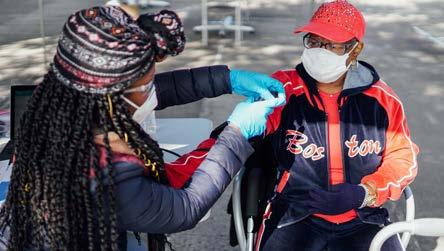
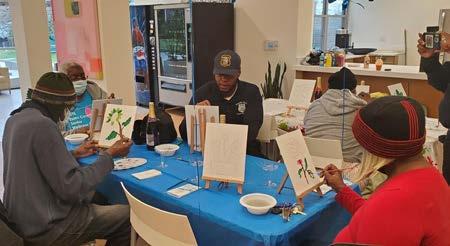


Mr. A (60’s, male)
• “Helps me to do something about my weight”.
• He has been exercising more regularly (utilizing the Grace West gym) thanks to TIPs.
• Mr. A has lost 7 lbs. since beginning the TIPs program.
• He also shared that he always takes his TIPs sheet with his vital readings on it to his doctor’s appointments so that he and his PCP can have a fuller discussion about his health.


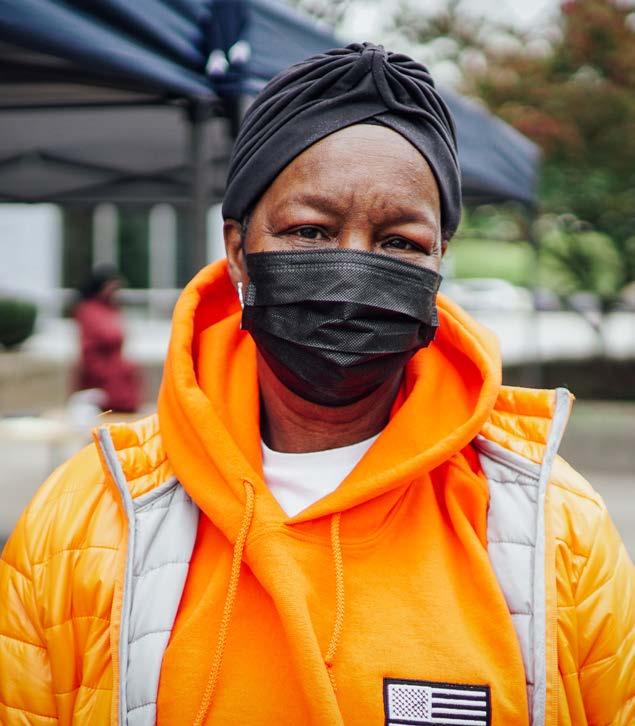
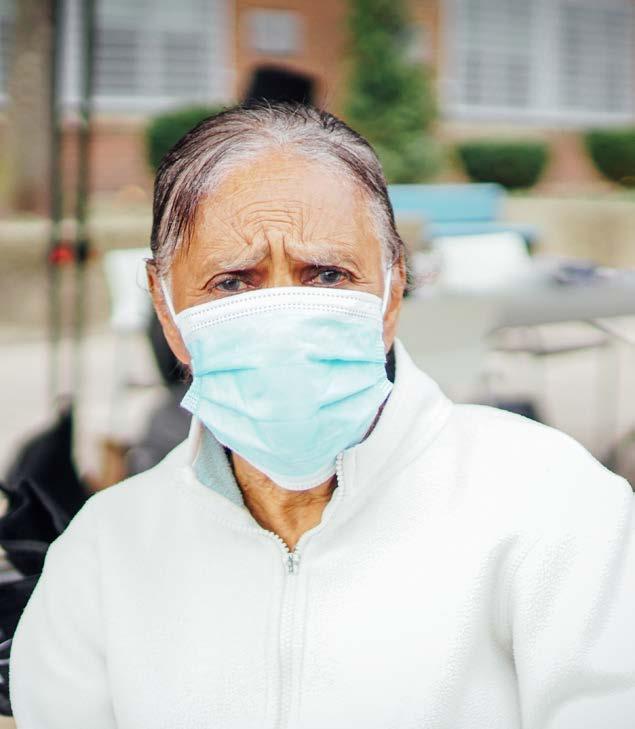
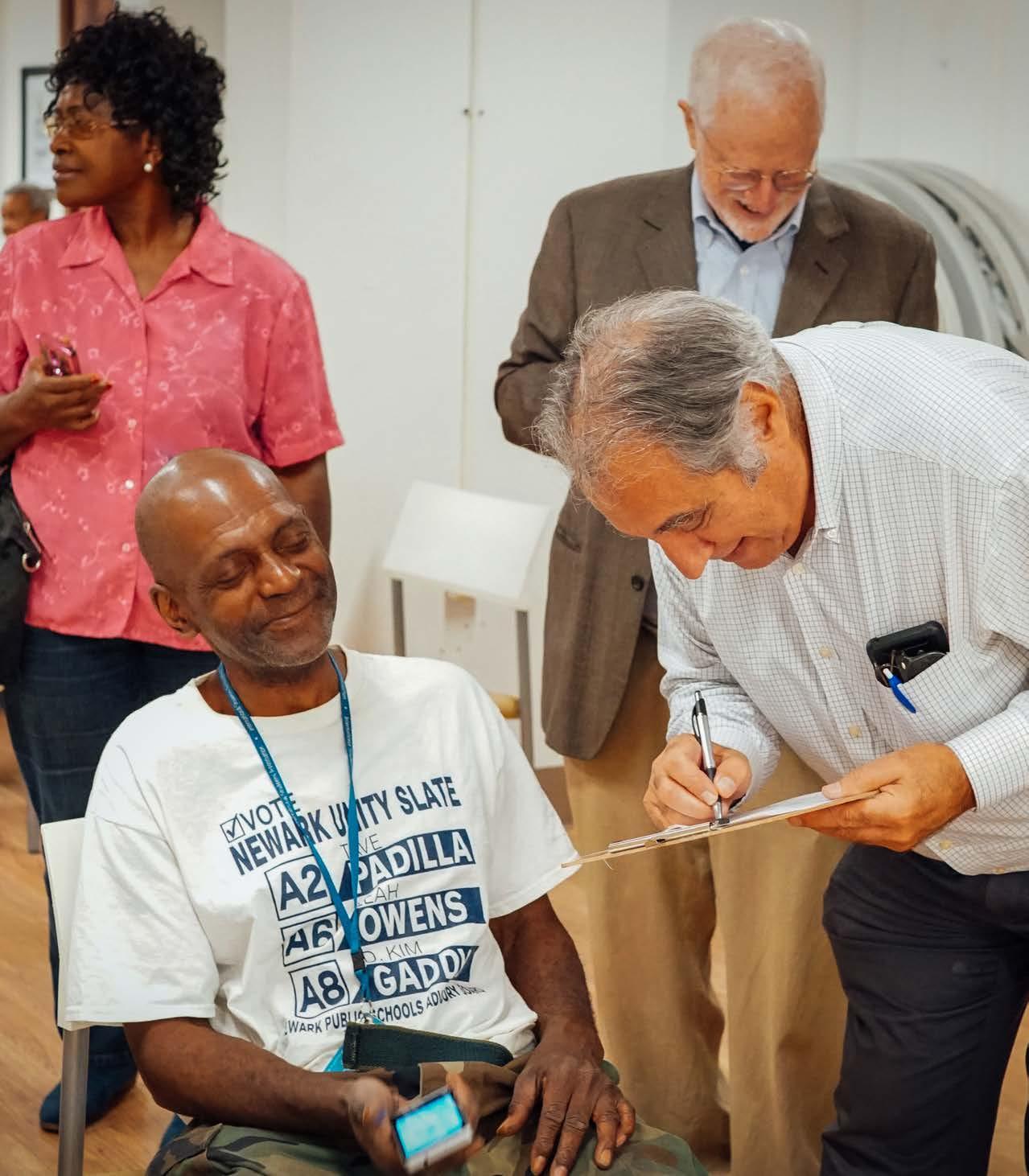
TIPs is a unique health program that combines weekly health screenings with community development programming in an affordable housing setting. For populations with limited access to care, bringing care to the patients at their place of residence has the potential to alter the culture of health. This report indicates the continued ways that TIPs as a telehealth program can improve the lives of those who participate by bringing health services to their community. The provision of the telehealth service, together with wrap around services, helps to begin to address the health inequities that exist and delivers a meaningful and valued health resource to historically underserved communities.
Preserving wellbeing and creating a culture of health may assist residents beyond their health to affect economic outcomes, such as maintaining their housing situation. We found suggestive evidence that frequent participation in TIPs leads to improved measures of housing stability as measured by ledger balance and eviction proceedings.
We hope to continue to sustain the TIPs program at Grace West with additional funding,and scale to other affordable housing properties. Beyond creating a stronger culture of health at other properties, we hope scaling will allow us to further analyze the intersection between TIPs and health care savings and housing stability.
The TIPs program consistently shows decreases in health metrics such as hospitalization rates, 30–day readmission rates and occurrence of falls. We have also seen an improvement in self-reported measures of physical and mental health, and increased COVID vaccine take-up. Through routine contact with health care providers, TIPs may increase trust in the medical care system and improve use of preventative care.